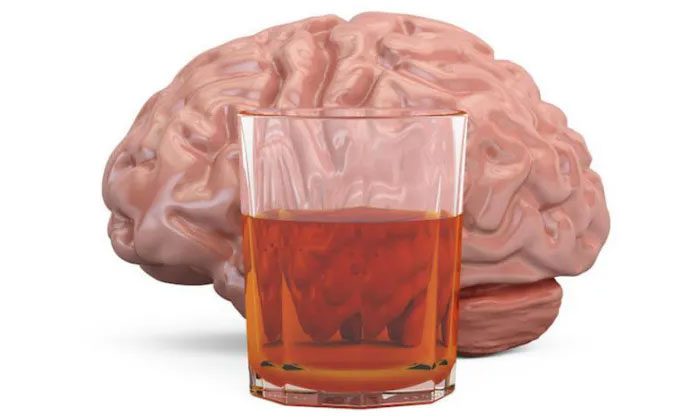A study utilizing data from over 36,000 adults reveals that drinking one to two glasses of alcohol daily is associated with brain changes equivalent to two years of aging. Higher alcohol consumption is linked to even greater declines.
The science surrounding heavy drinking and brain health is clear: Heavy drinkers exhibit structural and size changes in the brain associated with cognitive decline.
However, according to a new study, consuming alcohol even at levels most people consider modest—such as a few beers or glasses of wine per week—can also pose risks to the brain. An analysis of data from over 36,000 adults, led by a research team from the University of Pennsylvania, shows that light to moderate alcohol consumption is related to a decrease in overall brain volume.
The researchers noted that the relationship becomes stronger with increased alcohol consumption. For instance, among individuals aged 50, when average alcohol intake rises from one unit (about half a beer) per day to two units (one liter of beer or one glass of wine), there are brain changes equivalent to two years of aging. Moving from two to three units of alcohol at the same age is akin to aging three and a half years. The research team reported their findings in the journal Nature Communications.

The relationship becomes stronger with increased alcohol consumption.
Gideon Nave, a corresponding author of the study and a lecturer at Penn’s Wharton, stated: “The fact that we have such a large sample size allows us to find subtle patterns, even between drinking the equivalent of half a beer and one beer per day.”
Kranzler, who directs the Penn Addiction Research Center, added: “These findings contrast with government and scientific guidelines on safe drinking limits. For example, while the National Institute on Alcohol Abuse and Alcoholism recommends that women consume no more than one drink per day on average, the recommended limit for men is double that, an amount that exceeds the consumption associated with decreased brain volume.
Extensive research has examined the relationship between alcohol consumption and brain health, with mixed results. While there is clear evidence that heavy drinking causes changes in brain structure, including significant reductions in gray and white matter, other studies have suggested that moderate drinking may have no effect, or even that light drinking could benefit older adults.
However, previous investigations lacked the power of large datasets. Tracking large amounts of data for samples is the expertise of Nave, Daviet, and their colleagues, who have conducted prior studies using the UK Biobank, a dataset containing genetic and health information from half a million middle-aged and older individuals in the UK. They utilized biospecimen data from this source in the current study, specifically examining brain MRIs from over 36,000 adults in the Biobank, which can be used to calculate the volume of white and gray matter in different regions of the brain.
Nave remarked: “Having this dataset is like having a microscope or a telescope with a stronger lens. You get better resolution and start to see patterns and links that you couldn’t see before.”
To understand the potential relationship between alcohol consumption and brain health, it is crucial to control for confounding variables that may obscure the relationship. The research team controlled for age, height, handedness, gender, smoking status, socioeconomic status, genetic ancestry, and residential district. They also adjusted brain volume data for overall head size.
Volunteers participating in the Biobank answered survey questions about their alcohol consumption, ranging from complete abstinence to an average of four or more units of alcohol per day. When researchers grouped participants by average consumption, a small but clear pattern emerged: The volume of gray and white matter could be predicted based on other characteristics of the individuals.
Moving from 0 to 1 unit of alcohol did not produce significant differences in brain volume, but increasing from 1 to 2 or 2 to 3 units per day was associated with reductions in both gray and white matter.
Daviet stated: “It’s not linear. “It gets worse the more you drink.”
Even after excluding heavy alcoholics from the analyses, associations remained. Scientists found that lower brain volume was not concentrated in any specific brain region.
To provide context for the impact, researchers compared the brain size reduction associated with alcohol consumption to instances of aging. Based on their model, each additional unit of alcohol consumed daily reflected a greater aging effect on the brain. While moving from 0 to an average daily intake of one unit of alcohol is equivalent to half a year of aging, the difference between no alcohol and drinking four times is over 10 years of aging.
In the future, the authors hope to leverage the UK Biobank and other large datasets to help answer additional questions related to alcohol use. “This study looked at average consumption, but we’re curious if having one beer each day is better than not drinking during the week and then having seven beers on the weekend,” Nave said. “There is some evidence that drinking beer is harmful to brain health, but we haven’t examined that closely yet.”
They also aim to clarify causal relationships rather than mere correlations, which may be possible with new longitudinal biospecimen datasets tracking younger individuals as they age.
Nave noted: “We can look at these effects over time and along with genetics, identifying different causal relationships.”
And while the researchers emphasize that their study only examined correlations, they suggest that these findings may prompt drinkers to reconsider their consumption levels.
Daviet remarked: “There is some evidence suggesting the impact of drinking on the brain is exponential. So, an additional drink in one day may have more effects than any drink earlier that day. This means that cutting back on the last drink of the evening could significantly affect brain aging.
In other words: “Those who may benefit most from drinking less are the ones who have been drinking the most,” Nave concluded.


















































